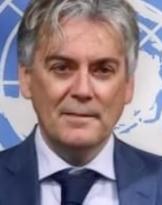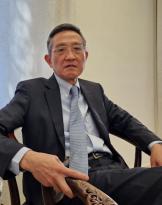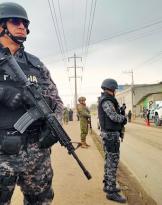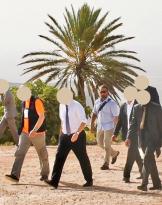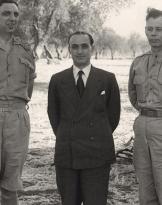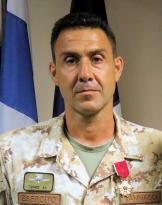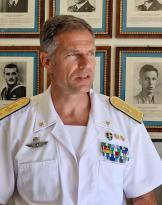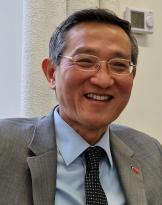Trafficking in human beings can undoubtedly be considered one of the most delicate contemporary crises. Its complex resolution, which today sees the European Union deployed at the forefront to combat criminal organizations that exploit the phenomenon of migratory flows driven by conflict, poverty and persecution in the North African area to profit from the trade in human beings, was entrusted to a Task Force inter-European commanded by Division Admiral of the Italian Navy Enrico Credendino who since 18 May 2015, from the European Union Naval Force (IT EU-OHQ) in Rome, commands and coordinates Operation EUNAVFOR MED 'SOPHIA' (v.approfondimento).
Defense Online has had the privilege and honor of interviewing the admiral Credendino, going to visit the headquarters to understand, and tell you, all the work behind the remarkable results of the inter-European effort to combat human smuggling.
Admiral, public opinion knows the final part of your work not knowing that upstream there is a complex structure busy day and night. What does the "unknown" work you do consist of?
All the work you can see here, in the IT EU OHQ of Rome, can give a dimension of the variety of actions we do and the cooperation needed to complete a complex mission, as important as EUNAVFOR MED. We are in the headquarters that Italy has made available to the European Union and where an international staff of 175 men operates divided into several specialized 'cells', each in a specific task. Like this there are other 4: the CPCO of Paris, the PJHQ of Northwood, the German EU OHQ of Potsdam and the Greek OHQ of Larissa. From 22 June 2015 (until 27 July 2017) all the international operations against human trafficking are coordinated from this OHQ.
I am in charge of the military strategic command; I designed the SOPHIA operation and I follow its every movement coordinating with our Operations Center which monitors the area in question 24 hours a day and with my interface on the 'high seas': Admiral Giuseppe Berutti Bergotto who is on board the Garibaldi aircraft carrier and commands the tactical part.
 I depend directly on the political security committee of the EU, therefore the high representative of the European Council Federica Morgherini and the ambassadors representing the member countries of the EU council. I have been involved and still manage all the reports necessary to design and carry out the EUNAVFOR MED operation (renamed 'SOPHIA' in honor of a Somali girl born on the German frigate Schleswig-Holstein (Photo) previously engaged in the operation). I have personally established all the contacts necessary to carry out the mission with the African Union, the Arab League, the United Nations and all its extensions, NATO and non-governmental organizations operating in the sea area affected by our 'operations'.
I depend directly on the political security committee of the EU, therefore the high representative of the European Council Federica Morgherini and the ambassadors representing the member countries of the EU council. I have been involved and still manage all the reports necessary to design and carry out the EUNAVFOR MED operation (renamed 'SOPHIA' in honor of a Somali girl born on the German frigate Schleswig-Holstein (Photo) previously engaged in the operation). I have personally established all the contacts necessary to carry out the mission with the African Union, the Arab League, the United Nations and all its extensions, NATO and non-governmental organizations operating in the sea area affected by our 'operations'.
The staff working in the OHQ is divided into different teams: plans, operations, intelligence; there is a staff that goes through all the legal aspects and there are 3 fundamental 'political advisors': highly qualified elements that essentially deal with 'understanding how the outside world works'. These are all fundamental cogs to build the operation: understand the functioning of the migrant business model, how the illicit trafficking of arms that ends up in Libya works and act to fight these crimes as effectively as possible in full compliance with rules and conventions.
Through the 'Operations Center', armed with 7 days on 7, h24, and through and the other key figures of the OHQ who are, as they say 'always at the piece', I am constantly informed about every movement in the stretch of sea concerned; even when I'm in Brussels to meet with the leaders of the EU council, I am in constant contact with our 'Force Commander' on the Garibaldi and wherever I am, I direct the operations directly.
Based on your experience, would your activity require an increase in resources and resources to carry out the task that the European Union has entrusted to you?
 Any operations commander would always want to have more means and more resources to carry out his mission more effectively (...) let's say that today we have a number of means and resources sufficient to move forward. New ships will arrive soon. To the 'Task Force' already composed of 5 naval units: the aircraft carrier Garibaldi, our 'FlagShip', the German auxiliary ship FGS Werra and the German minefighter FGS Datteln, the British survey vassel HMS Enterprise, the Spanish frigate 'Reina Sofia' ; and the 6 aircraft: a Luxembourg MPA SW3 Merlin III, a CN-235 Vigma D-4, two Italian AB212 helicopters, a SH90 and the French MPA Falcon 50), will be joined by a French ship, another British ship, and in October a Dutch ship, a Belgian ship, and a Portuguese submarine.
Any operations commander would always want to have more means and more resources to carry out his mission more effectively (...) let's say that today we have a number of means and resources sufficient to move forward. New ships will arrive soon. To the 'Task Force' already composed of 5 naval units: the aircraft carrier Garibaldi, our 'FlagShip', the German auxiliary ship FGS Werra and the German minefighter FGS Datteln, the British survey vassel HMS Enterprise, the Spanish frigate 'Reina Sofia' ; and the 6 aircraft: a Luxembourg MPA SW3 Merlin III, a CN-235 Vigma D-4, two Italian AB212 helicopters, a SH90 and the French MPA Falcon 50), will be joined by a French ship, another British ship, and in October a Dutch ship, a Belgian ship, and a Portuguese submarine.
This further use of resources by the member states derives from the fact that the operation is growing in numbers and consistency; in addition to fighting smugglers and human traffickers, we have received two additional tasks: the training of the Coast Guard, the Libyan Navy and the control of the arms embargo towards Libya in accordance with the resolutions of the UN Security Council . Italy will play a decisive role in this, since the training will be under Italian guidance and will take place on the amphibious ship San Giorgio (L9892), where the first stages of the Libyan Navy training will take place already in September.
Still according to his experience, could you tell us if you have found an evolution of the model followed by the criminal organizations involved in the trade in human beings?
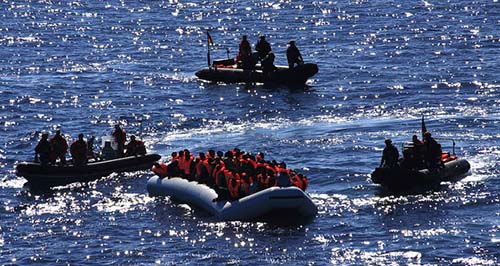
We start from the assumption that migration is an extremely complex phenomenon to analyze, subject to various variables and constantly changing. To date, we have received the mandate to operate exclusively in international waters: this essentially allows us to stop suspicious boats and prevent smugglers from recovering boats and rafts that were previously methodically abandoned after rescues to be reused for other 'trips'.
Since SOPHIA became operational (in the record time of one month from its planning) the smugglers were prevented from recovering the equipment used for their traffic: rubber dinghies, large wooden boats, outboard engines and GPS navigators were regularly seized and the sunken boats (to avoid leaving them adrift and risking collisions with other boats) inflicting a severe blow to these 'criminal organizations' which, as in the case of Libya, bear the 30-40% of the country's GDP. In addition to the deterrent effect, we have recorded 'concrete' effects, if we want to call them this: we are talking about 200 boats used for trafficking in neutralized human beings and the arrest of 75 scafisti. It is therefore evident how criminal organizations operate less effectively than before and how they had to 'adapt' to our presence.
Can you explain to our readers the strategic importance of your Operations Center?
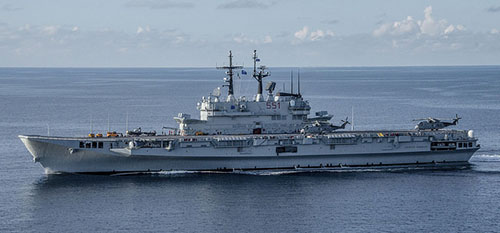 As I was saying, the Operations Center is connected to the Garibaldi aircraft carrier (substitute to Cavour) which is our Flag Ship and where our Force Commander is present. The purpose of the Operations Center, equipped with the same FRONTEX information exchange system, is to learn about everything that happens in the Mediterranean marine environment. From this room operators monitor 24 hours a day everything that happens in the area of operations in which SOPHIA intervenes - the so-called Maritime Situational Awareness - and this allows us to understand simplistically 'who and who are the good guys and who are the bad guys' for intervene when necessary and oppose the smugglers, the human traffickers, and to implement the embargo of the weapons that come and are sent to Libya.
As I was saying, the Operations Center is connected to the Garibaldi aircraft carrier (substitute to Cavour) which is our Flag Ship and where our Force Commander is present. The purpose of the Operations Center, equipped with the same FRONTEX information exchange system, is to learn about everything that happens in the Mediterranean marine environment. From this room operators monitor 24 hours a day everything that happens in the area of operations in which SOPHIA intervenes - the so-called Maritime Situational Awareness - and this allows us to understand simplistically 'who and who are the good guys and who are the bad guys' for intervene when necessary and oppose the smugglers, the human traffickers, and to implement the embargo of the weapons that come and are sent to Libya.
Could you take stock of the SOPHIA operation?
The balance is very positive. SOPHIA is the result of the concrete will of the European Union to act as a 'Union': activating a naval / maritime operation under its entire leadership in the Mediterranean to stem the human trafficking crisis. The operation, launched in the record time of one month, boasts the further - and perhaps most important record - as an operation with the largest number of member members ever recorded in an EU mission: in fact 24 countries (AUT, BEL, BGR, CYP, CZE, ESP, EST, FIN, FRA, GER, GBR, GRE, HUN, ITA, LAT, LIT, LUX, MAL, NED, POL, POR, ROM, SLO, SWE). Each country actively contributes by sending ships, planes, logistical support or essential boarding teams.
How do you see the coordination of the EUNAVFOR MED device with all other operations taking place at sea, for example Mare Sicuro and Triton by FRONTEX?
 The coordination is excellent and is to be considered as the strong point of the whole operation. There is a memorandum of understanding with Frontex, with NATO and with the independent countries that have sent ships that contribute to the joint operations in the Mediterranean Sea but remain nationally led (this is the case of Ireland at the moment). I have liaison officers at the FRONTEX agency and they have liaison officers at our OHQ to cooperate in a synergistic and dynamic way. The same also happens with 'Safe Sea'.
The coordination is excellent and is to be considered as the strong point of the whole operation. There is a memorandum of understanding with Frontex, with NATO and with the independent countries that have sent ships that contribute to the joint operations in the Mediterranean Sea but remain nationally led (this is the case of Ireland at the moment). I have liaison officers at the FRONTEX agency and they have liaison officers at our OHQ to cooperate in a synergistic and dynamic way. The same also happens with 'Safe Sea'.
I mention for example the blocking of two boats and the consequent discovery and arrest of 17 smugglers took place in perfect cooperation with the units deployed in the 'Safe Sea' operation: the two suspicious boats were intercepted by our English unit with the help of one of the Italian helicopters, but because they are too far away, the information was immediately passed to the 'Safe Sea' units that intervened to block the boats by seizing them and arresting the smugglers.
Cooperation with NGOs through the exchange of information on our common SHADE MAD forum is also essential. There, our 'working groups' in constant contact coordinate to work as effectively as possible and is our great strength. At the last meeting of the SHADE MED Forum, last May 145 representatives from 74 participated in various civil, military and non-governmental organizations. This has brought many advantages in cooperation to combat human trafficking more and more effectively.
 (photo: EUNAVFOR MED)
(photo: EUNAVFOR MED)


